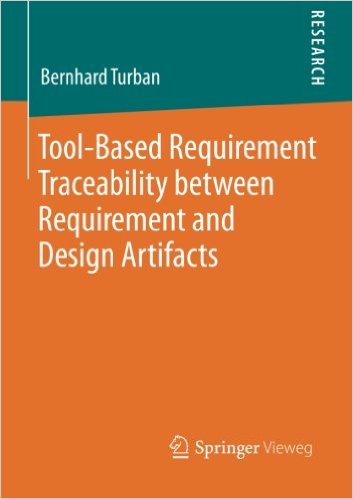Forschungsaktivitäten
Aktuelle Projekte
Derzeit arbeite ich an einem Buchprojekt, das versucht mittels einer musterbasierten Beschreibung sich dem Thema Fehlerbehandlung in Software einmal umfassend zu widmen.Publikationsliste
[2018B] Aysolmaz, B.; Gürsul, M.; Kirchner, K.; Laue, R.; Mertens, R.; Reher, F.; Schönreiter, I.; Turban, B; Weißbach, R.: A Reflection on the Interrelations Between Business Process Management and Requirements Engineering with an Agility Perspective. In: Teniente, E.; Weidlich, M. (eds.): Business Process Management Workshops. BPM 2017. Lecture Notes in Business Information Processing, vol 308. Springer, Cham 2018.
[2018A] Turban, B.; Schmitz-Lenders, J.: A Pattern-Based Question Checklist for Deriving Requirements from BPMN Models. In: Teniente, E.; Weidlich, M. (eds.): Business Process Management Workshops. BPM 2017. Lecture Notes in Business Information Processing, vol 308. Springer, Cham 2018.
[2017A] Turban, B.; Schmitz-Lenders, J.: Musterbasierte Fragenchecklisten zur Ableitung von Anforderungen aus modellierten Geschäftsprozessen. In: Eibl, M.; Gaedke, M. (Eds.): INFORMATIK 2017. Gesellschaft für Informatik, Bonn (S. 843-848), (Online Version).
[2013] Turban, B.: Tool-Based Requirement Traceability between Requirement and Design Artifacts, Vieweg+Teubner Verlag, April, 2013. (Siehe nähere Beschreibung unten)
[2009A] Turban, B., Kucera, M., Tsakpinis, A., & Wolff, C.: Bridging The Requirements To Design Traceability Gap; In: M., Natividad; R. Seepold (Eds.): Intelligent Technical Systems. Series: Lecture Notes in Electrical Engineering, Vol. 38, 2009.
[2008B] Turban, B.; Kucera, M.; Tsakpinis, A.; Wolff, Ch.: Erweiterte Traceability zwischen Anforderungen und Design. Embedded Software Engineering Kongress, Sindelfingen, Dezember 2008. (Online Version)
[2008A] Turban, B.; Wolff, Ch.; Tsakpinis, A.; Kucera, M.: A Decision Model for Managing and Communicating Resource Restrictions in Embedded Systems Design. In: Proc. Sixth IEEE Workshop on Intelligent Solutions in Embedded Systems, WISES 2008, Regensburg, Juli 2008.
[2007B] Turban, B.; Kucera, M.; Tsakpinis, A.; Wolff, C.: An Integrated Decision Model for Efficient Requirement Traceability In SPICE Compliant Development. Paper presented at the WISES 2007. Fifth Workshop on Intelligent Solutions in Embedded Systems, 2007. (Online Version)
[2007A] Turban, B.; Tsakpinis, A.; Wolff, C.: Ein Entscheidungsmodell für das Tracing von Anforderungen. In: Software Engineering 2007 (SE 2007). Bonn: Köllen Verlag [= Lecture Notes in Informatics, Vol. 105], 2007.

Abstract des Buchs "Tool-Based Requirement Traceability between Requirement and Design Artifacts"
Developing safety-critical systems imposes special demands for ensuring quality and reliability of the developed systems. Process standards such as SPICE (ISO15504) or CMMI have been developed to ensure high quality processes, leading to the development of high quality systems. Central principles of these standards are demands for requirements traceability. Traceability means comprehensible documentation of all origins and later influences of a requirement throughout the complete development endeavor. Among other uses ascribed, the traceability concept tries to ensure that every requirement is adequately considered in development and that if changes on the requirement are needed, impacts of these changes can be adequately estimated and consistently implemented later on. Even though the traceability concept seems promising in theory, it faces substantial problems in practice. One problem is that despite the needed efforts, the perceived benefits for developers are often low because the quality of captured traceability information is often coarse grained, does not prove helpful in the situational context, or has already degraded.
This thesis tries to show that traceability between requirements and design is an especially difficult problem. To analyze the problem context, the thesis at first analyzes theories, in which the problem is cross-cutting. These are embedded systems development, systems engineering, software engineering, requirements engineering and management, design theory and process standards for safety-critical systems.
This analysis mainly identifies a twofold gap between the requirements and the design domain. Obviously a tooling gap exists because different tools are used for the requirements and design domain. However, more important, between requirement descriptions and designs a substantial inherent gap exists because design is a creative decision process of designers often guided by intuition and tacit knowledge thus difficult to trace by current traceability concepts. To prove this argumentation, the author analyzes four design theories (symbolic information processing (Simon), wicked problems (Rittel), reflective practice (Schoen) and patterns (Alexander)). As a solution to the gap problem, the thesis introduces a tool-based traceability method that supports designers in their thinking, avoids disturbing designers in their intuitive phases of creativity, allows establishing traceability nearly as a by-product, provides early benefit to designers, improves collaboration between designers and extends usual traceability concepts by two integrated decision models allowing further decision information (rationale) to be documented. The decision models also allow deriving new design internal “requirements” (design constraints and budgeted resource constraints) as consequences. In this way, it is possible to clearly distinguish real requirements originating from customers from “requirements” arising from internal decision processes during design leading to the definition of a “requiremental items taxonomy”. As the thesis further shows, these concepts also prove to be helpful to avoid unnecessary redundancies in the artifact process models of SPICE (ISO15504) or CMMI, where different requirement (system requirements, hardware requirements and software requirements) and design artifacts (system design, hardware design and software design) are considered in their interplay. Last but not least, mechanisms for graphical impact analysis, consistency management and supplier management complete the approach.
Through funding of the support program IUK-Bayern, the results presented here could be integrated into a commercial tool solution called PROVEtech:R2A, now offered by the MBtech Group, as a decisive means to significantly improve requirement-based design processes with improved support to achieve real benefit from the traceability concept.
